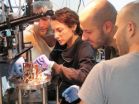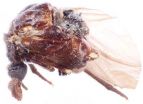(Press-News.org) For the Spanish Royal Academy, senescent is he who "begins to age". But laboratory biology results are contradicting the dictionary: not only is senescence not a synonym of ageing, it is also not intrinsically negative for the organism. Cellular senescence is such a badly named physiological process that those who do research in this area think it needs another name. That is the case of Manuel Serrano, from the Spanish National Cancer Research Centre (CNIO), one of the world's leading experts on senescence, who has just published a review on this topic. Without actually renaming senescence, this edition of Nature Reviews promotes a paradigm shift: senescence is, above all, "a mechanism to eliminate unwanted cells", which ends with the remodelling of tissues. And it can be something of a double-edged sword for the body.
More than five decades ago, Leonard Hayflick and Paul Moorhead discovered that healthy human cells growing in culture stop proliferating after a certain number of divisions. They called the phenomenon cellular senescence and postulated that it could be the cause of ageing in the body. But more recent research, led largely by Serrano and his group—Daniel Muñoz-Espín is co-author of the current revision—has shown that this pioneering observation only told part of the story.
Today, we know that the relationship between senescence and ageing resembles that between firemen and fire: although there are many firemen at a fire, they are not the cause of the blaze but rather an attempt to put it out. In a similar way, Serrano and Muñoz-Espín propose that senescence activates when there is damage to a cell, to prevent it from spreading or even to repair the affected tissue. In ageing organisms, what happens is that the process stops halfway with a large number of senescent cells present in the tissues.
The authors talk of a sequence of events: "Senescence-clearance-regeneration". "Recent discoveries are redefining our vision of cellular senescence", they write. To achieve their goal: "senescent cells inhibit their own proliferation, induce their own elimination by attracting cells from the immune system and finally promote tissue regeneration". In aged tissues or with certain diseases, however: "this sequence is not completed, and the senescent cells accumulate".
That is why: "senescence can become part of the problem with ageing, instead of the solution", write the authors.
Today it is known that cells initiate their senescence programme in response to stimulants such as the activation of different oncogenes—cancer-causing genes; the absence or malfunction of anti-cancer genes; or the shortening of telomeres, the protein structures that protect the ends of chromosomes. All of these stimulants damage cells and senescence then works as a protective mechanism.
Furthermore, Serrano and Muñoz-Espín have recently discovered that senescence intervenes in another key process for the organism, in a stage very far removed from ageing: development. As the embryo grows, it needs to get rid of or redesign physiological structures, and the genetic orders it uses to that end are those related to senescence.
This discovery has allowed these researchers to complete their vision of senescence as a mechanism that is really there to: "eliminate unwanted cells" and end up regenerating tissue, even with a different than the one it had previously.
In this new vision, therefore, senescence is just a physiological mechanism. The question is: should we stimulate it, to fight cancer, for example, or should we prevent it, to stop ageing? Both, say the researchers.
The revision presents a list of pathologies in which senescence can have either a beneficial or harmful effect. In several types of cancer, for example, senescence stops the advance of the disease; in cardiovascular disease, it restricts atheroma formation; it is also beneficial against several types of fibrosis. With obesity and diabetes, however, it favours disease development, increasing resistance to insulin and inflammation.
Clinical research also reflects the two faces of senescence, given that both therapies based on promoting it—specifically against cancer and kidney and liver fibrosis—and on stopping it are being studied. The authors underline the success in breast cancer trials of a new drug that stimulates senescence: palbociclib.
But they leave one mystery unsolved: moles. Nowadays we know that moles are collections of senescent cells that have not been eliminated. Why? To be continued.
INFORMATION:
Reference article:
Cellular senescence: from physiology to pathology. Muñoz-Espín D, Serrano M. Nature Reviews Molecular Cell Biology (2014). doi: 10.1038/nrm3823
Manuel Serrano proposes a new vision of a process wrongly associated with ageing
2014-07-14
ELSE PRESS RELEASES FROM THIS DATE:
Validity of change in DSM-5 ADHD age of onset criterion confirmed
2014-07-14
Washington D.C., July 14, 2014 – A recent study published in the July 2014 issue of the Journal of the American Academy of Child and Adolescent Psychiatry confirms the validity of the DSM-5 change to the age of onset criterion for diagnosis of attention-deficit/hyperactivity disorder (ADHD).
In DSM-5, age of onset criterion for ADHD, previously set at 7 in DSM-IV, has been raised to 12. As explained in DSM-5, age of onset is now set at 12, rather than an earlier age, to reflect the importance of clinical presentation during childhood for accurate diagnosis, while also ...
'Noisy' memory in schizophrenia
2014-07-14
Philadelphia, PA, July 14, 2014 – The inability to ignore irrelevant stimuli underlies the impaired working memory and cognition often experienced by individuals diagnosed with schizophrenia, reports a new study in the current issue of Biological Psychiatry.
Our brains are usually good at focusing on the information that we are trying to learn and filtering out the "noise" or thoughts that aren't relevant. However, memory impairment in schizophrenia may be related in part to a problem with this filtering process, which Dr. Teal Eich at Columbia University and her colleagues ...
Flashes of light on the superconductor
2014-07-14
Superconductors are futuristic materials that will hopefully have a broad range of technological applications at some time in the future (medical imaging, transport…). Today's use is limited by the extremely low temperatures (close to absolute zero) required for superconductivity to manifest. However, some families of these materials work at "relatively" high temperatures (about - 200° C), and it's on these that scientists are focusing their attention. Among them are copper-based superconductors, which have very unique characteristics. A study conducted by researchers of ...
New theory turns cancer on its head
2014-07-14
A new theory of how cancer works could lead to the next generation of treatments of the disease.
The theory suggests that cancer forms when recently evolved genes are damaged, and cells have to revert to using older, inappropriate genetic pathways.
Astrobiologists Dr Charley Lineweaver from The Australian National University and Professor Paul Davies from Arizona State University teamed up with oncologist Dr Mark Vincent from the University of Western Ontario to develop the new model.
"The rapid proliferation of cancer cells is an ancient, default capability that ...
3D printed anatomy to mark a new era for medical training
2014-07-14
The creators of a unique kit containing anatomical body parts produced by 3D printing say it will revolutionise medical education and training, especially in countries where cadaver use is problematical.
The '3D Printed Anatomy Series', developed by experts from Monash University, is thought to be the first commercially available resource of its kind. The kit contains no human tissue, yet it provides all the major parts of the body required to teach anatomy of the limbs, chest, abdomen, head and neck.
Professor Paul McMenamin, Director of the University's Centre for ...
Physical fitness associated with less pronounced effect of sedentary behavior
2014-07-14
ATLANTA – July 14, 2014 –Physical fitness may buffer some of the adverse health effects of too much sitting, according to a new study by researchers from the American Cancer Society, The Cooper Institute, and the University of Texas. The study appears in the journal Mayo Clinic Proceedings, and finds the association between prolonged sedentary time and obesity and blood markers associated with cardiovascular disease is markedly less pronounced when taking fitness into account.
Sedentary behavior has been linked to an increase risk of obesity, metabolic syndrome, type ...
Domestication syndrome: White patches, baby faces and tameness
2014-07-14
More than 140 years ago, Charles Darwin noticed something peculiar about domesticated mammals. Compared to their wild ancestors, domestic species are more tame, and they also tend to display a suite of other characteristic features, including floppier ears, patches of white fur, and more juvenile faces with smaller jaws. Since Darwin's observations, the explanation for this pattern has proved elusive, but now, in a Perspectives article published in the journal GENETICS, a new hypothesis has been proposed that could explain why breeding for tameness causes changes in such ...
UEA research reveals how cannabis compound could slow tumour growth
2014-07-14
Scientists at the University of East Anglia have shown how the main psychoactive ingredient in cannabis could reduce tumor growth in cancer patients.
Research published today reveals the existence of previously unknown signaling platforms which are responsible for the drug's success in shrinking tumours.
It is hoped that the findings could help develop a synthetic equivalent with anti-cancer properties.
The research was co-led with the Universidad Complutense de Madridin, Spain. The team used samples of human breast cancer cells to induce tumours in mice. They ...
The world's first photonic router
2014-07-14
Weizmann Institute scientists have demonstrated for the first time a photonic router – a quantum device based on a single atom that enables routing of single photons by single photons. This achievement, as reported in Science magazine, is another step toward overcoming the difficulties in building quantum computers.
At the core of the device is an atom that can switch between two states. The state is set just by sending a single particle of light – or photon – from the right or the left via an optical fiber. The atom, in response, then reflects or transmits the next incoming ...
Serendipity at the Smithsonian: The 107-year journey of the beetle Rhipidocyrtus muiri
2014-07-14
Serendipity leads University of Kansas scientists to the discovery and description of Rhipidocyrtus muiri - a 107 year old, lost in collections specimen, which turned out to represent a new genus and species. The long and tortuous history of the enigmatic ripidiine wedge beetle from Borneo is discussed in a recent paper published in the open access journal ZooKeys.
The holotype male, and only known specimen of Rhipidocyrtus muiri, was collected 107 years ago in Borneo but subsequent to this it was transferred among several researchers in the early 1900s. The specimen ...



